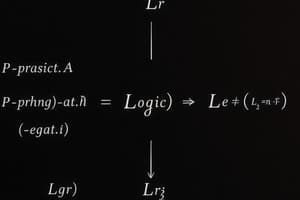Podcast
Questions and Answers
Which of the following statements is a proposition?
Which of the following statements is a proposition?
- Read this carefully.
- What time is it?
- Washington, D.C., is the capital of the United States of America. (correct)
- x + 1 = 2.
All declarative sentences are propositions.
All declarative sentences are propositions.
False (B)
What is the conventional letter used for propositional variables?
What is the conventional letter used for propositional variables?
p, q, r, s, etc.
What does the truth value 'T' represent?
What does the truth value 'T' represent?
What does the truth value 'F' represent?
What does the truth value 'F' represent?
Which philosopher is known for developing the propositional calculus?
Which philosopher is known for developing the propositional calculus?
Aristotle was born in _________.
Aristotle was born in _________.
What is the result of the conjunction $p \land q$ when both propositions are true?
What is the result of the conjunction $p \land q$ when both propositions are true?
In a truth table, what does the exclusive or (XOR) operation $p \oplus q$ yield when both $p$ and $q$ are true?
In a truth table, what does the exclusive or (XOR) operation $p \oplus q$ yield when both $p$ and $q$ are true?
What is the outcome of the conditional statement $p \rightarrow q$ when $p$ is false and $q$ is true?
What is the outcome of the conditional statement $p \rightarrow q$ when $p$ is false and $q$ is true?
Which of the following accurately describes the truth value of $p \vee q$ when both propositions are false?
Which of the following accurately describes the truth value of $p \vee q$ when both propositions are false?
When are the propositions in a truth table considered to be contradictory?
When are the propositions in a truth table considered to be contradictory?
How many rows are present in a truth table for two propositions?
How many rows are present in a truth table for two propositions?
What does a conjunction of two propositions represent in a truth table?
What does a conjunction of two propositions represent in a truth table?
Which statement is true regarding the disjunction of two propositions in a truth table?
Which statement is true regarding the disjunction of two propositions in a truth table?
What is the main purpose of a truth table in propositional logic?
What is the main purpose of a truth table in propositional logic?
How many possible combinations of truth values exist for two propositions?
How many possible combinations of truth values exist for two propositions?
Flashcards are hidden until you start studying
Study Notes
Propositions in Logic
- Propositions are declarative sentences that assert facts and are either true or false, not both.
- Examples of propositions:
- "Washington, D.C., is the capital of the United States." (True)
- "Toronto is the capital of Canada." (False)
- "1 + 1 = 2." (True)
- "2 + 2 = 3." (False)
- Non-propositional sentences include:
- "What time is it?" (Not declarative)
- "Read this carefully." (Not declarative)
- "x + 1 = 2" and "x + y = z" (Not true or false without assigned values)
- Propositional variables (p, q, r, s, etc.) are used to represent propositions in logical expressions.
Truth Values
- A true proposition is denoted by T.
- A false proposition is denoted by F.
Aristotle and the Foundations of Logic
- Aristotle (384-322 B.C.E.) was a significant figure in developing propositional logic.
- He was born in Stagira, Greece, and his father was the physician to the King of Macedonia.
- Orphaned at a young age, Aristotle was educated in various subjects, including poetry and Greek rhetoric.
- At 17, he attended Plato's Academy in Athens, where he studied and eventually lectured for around 20 years.
- After Plato's death in 347 B.C.E., Aristotle did not succeed him as the head of the Academy.
Truth Tables Overview
- Truth tables are visual representations to determine the truth values of compound propositions formed from basic propositions.
- Each row in a truth table corresponds to a distinct combination of truth values for its propositions.
Key Logical Connectives
- Conjunction (p ∧ q): True only if both p and q are true.
- Disjunction (p ∨ q): True if at least one of p or q is true.
- Exclusive Or (p ⊕ q): True if p and q have different truth values; false if they are the same.
- Conditional Statement (p → q): True unless p is true and q is false.
Structure of Truth Tables
- Truth tables contain columns for each proposition and the resulting compound statement.
- The total number of rows in a truth table depends on the number of propositions involved, specifically 2^n, where n is the number of propositions.
- For two propositions, there are four possible combinations of truth values (TT, TF, FT, FF).
Compound Propositions
- Compound propositions are created using logical connectives to combine simpler propositions.
- Important for analyzing conditions under which statements are true or false.
Importance of Truth Tables
- Essential in logic, mathematics, and computer science for evaluating logical expressions and determining their validity.
- Helps in understanding and constructing logical arguments and reasoning processes.
Studying That Suits You
Use AI to generate personalized quizzes and flashcards to suit your learning preferences.



